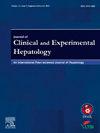Improved Outcomes of Liver Transplantation in Patients With Hepatitis C, Following the Introduction of Innovative Antiviral Therapies
IF 3.3
Q2 GASTROENTEROLOGY & HEPATOLOGY
Journal of Clinical and Experimental Hepatology
Pub Date : 2024-10-16
DOI:10.1016/j.jceh.2024.102428
引用次数: 0
Abstract
Background
The treatment landscape for hepatitis C virus (HCV) underwent a significant shift with the introduction of direct-acting antiviral (DAA) medications in late 2013. This study aimed to evaluate the impact of DAAs on liver transplantation outcomes, examining both the benefits and any potential drawbacks associated with their use.
Methods and materials
A retrospective registry analysis of the United Network for Organ Sharing database was done for liver transplants in patients diagnosed with hepatitis C, that were performed in the United States from January 2000 to May 2020.
Results
The study was divided into two subgroups, based on the timing of the new DAA medication that FDA approved. The only significant difference between the two cohorts is the recipient's age. The data analysis showed a significant overall 5-year graft survival improvement in the 2014–2020 group compared with the 2000–2013 group, from a mean of 64.8% in 2000–2013 to a mean of 76% in 2014–2020 (P < 0.001). Interestingly, when we compared the 5-year graft survivals with recipients who had a donor above age 50, the graft survival rate difference was even more significant (74% vs. 56%, P < 0.001) as some studies have shown a suboptimal graft outcome when the donor age is above 40 years old. Not only has the utilization of donation after circulatory death livers increased significantly after 2014 but the graft survival in this cohort has also been significantly higher (P < 0.001).
Conclusion
The emergence of DAAs in 2013 marked a watershed moment in the management of HCV offering high cure rates, minimal side effects, and shorter treatment durations to a point that the short- and long-term outcomes of liver transplantation for HCV is almost equal to the other causes of liver transplantation.
采用创新抗病毒疗法后丙型肝炎患者肝移植的疗效得到改善
背景随着2013年底直接作用抗病毒药物(DAA)的引入,丙型肝炎病毒(HCV)的治疗格局发生了重大转变。本研究旨在评估DAAs对肝移植结果的影响,研究与使用DAAs相关的益处和潜在弊端。方法和材料对器官共享联合网络数据库中2000年1月至2020年5月期间在美国进行的丙型肝炎患者肝移植手术进行了回顾性登记分析。两组之间唯一的明显差异是受试者的年龄。数据分析显示,与 2000-2013 年组相比,2014-2020 年组的总体 5 年移植物存活率明显提高,从 2000-2013 年的平均 64.8% 提高到 2014-2020 年的平均 76%(P <0.001)。有趣的是,当我们比较捐献者年龄在 50 岁以上的受者的 5 年移植物存活率时,移植物存活率的差异更为显著(74% vs. 56%,P < 0.001),因为一些研究显示,当捐献者年龄超过 40 岁时,移植物的结果并不理想。结论2013年DAAs的出现标志着HCV治疗的分水岭,其治愈率高、副作用小、治疗时间短,HCV肝移植的短期和长期疗效几乎与其他原因的肝移植相同。
本文章由计算机程序翻译,如有差异,请以英文原文为准。
求助全文
约1分钟内获得全文
求助全文
来源期刊

Journal of Clinical and Experimental Hepatology
GASTROENTEROLOGY & HEPATOLOGY-
CiteScore
4.90
自引率
16.70%
发文量
537
审稿时长
64 days
 求助内容:
求助内容: 应助结果提醒方式:
应助结果提醒方式:


